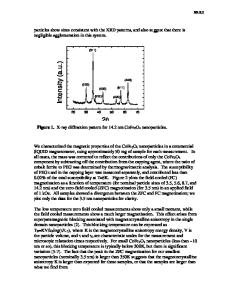Application of CoFe 2 O 4 @SiO 2 @Chitosan Nanoparticles for Cadmium (II) Preconcentration in Totally Different Samples
- PDF / 1,510,596 Bytes
- 12 Pages / 595.276 x 790.866 pts Page_size
- 87 Downloads / 351 Views
ORIGINAL PAPER
Application of CoFe2O4@SiO2@Chitosan Nanoparticles for Cadmium (II) Preconcentration in Totally Different Samples and its Determination through ETAAS Matin Naghizadeh 1,2
&
Mohammad Ali Taher 1 & Ali-Mohammad Tamaddon 3,4
Received: 29 June 2020 / Accepted: 18 August 2020 # Springer Nature B.V. 2020
Abstract X-Ray Diffraction (XRD), Fourier Transform Infrared Spectroscopy (FT-IR), Vibrating Sample Magnetometer (VSM), Transmission Electron Microscopy (TEM) and Scanning Electron Microscopy (SEM), were all used for purposes of the exploration of different characteristics on the part of the synthesized nanocomposite. Magnetic nanoparticles with chitosan are thought to be very efficacious absorbers to metal ions. It was for this reason that our research was set on producing them through a quick (and, the same time, simple) procedure. To prepare such a novel compound as CoFe2O4@SiO2@Chitosan, the application was made of CoFe2O4 magnetic nanoparticles’ co-precipitation property. Our method was capable of producing the novel CoFe2O4@SiO2@Chitosan most successfully so much so that CoFe2O4 nanoparticles were properly anchored onto chitosan itself. It was also part of our methodology to take advantage of CoFe2O4@SiO2@Chitosan nanoparticles as sorbents to remove Cd (II) ions from the related aqueous solutions. Our best effort was made to enhance differing factors’ effects employing bringing about optimal conditions. These factors comprised of pH adsorbent type, contact ultrasonication times, and acid concentration. The detection limit was finally arrived at by the level of 1.55 ng L−1. The cadmium linear range fell in between 0.007 and 0.500 ng mL −1. The statistical SD for all of the eight replicates turned out to be ±2.7% [0.50 ng mL−1] of Cd (II): this was, of course, based on the approach inside the present article. Keywords CoFe2O4@SiO2@chitosan nanoparticles . Magnetic nanoparticles . Water purification . Metal ions absorbers
1 Introduction Cadmium (Cd) has quite recently found wide applications in producing dental, electrical industry, jewelry, and medicinal devices [1, 2]. Moreover, this element has also had its
* Matin Naghizadeh [email protected] * Mohammad Ali Taher [email protected] 1
Department of Chemistry, Shahid Bahonar University of Kerman, 22 Bahman Boulevard, P.O. Box 76169-133, Kerman, Iran
2
Young Researchers Society, Shahid Bahonar University of Kerman, Kerman, Iran
3
Center for Nanotechnology in Drug Delivery, Shiraz University of Medical Sciences, Shiraz, Iran
4
Department of Pharmaceutics, School of Pharmacy, Shiraz University of Medical Sciences, Shiraz, Iran
applications in 3-way catalyst exhaust gas conversion. Additionally, from the standpoint of human health, considerable attention has been paid to nearly all heavy metals (not excluding Cadmium) for reasons of their role in conditions such as allergy, asthma, and yet other serious health problems over and above their effects in environmental pollution [3–5]. As far as environmental issues are concerned, Cadmi
Data Loading...










